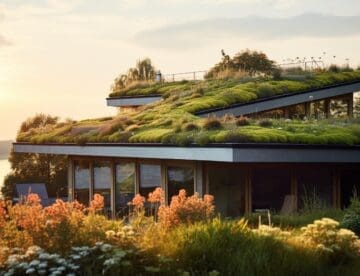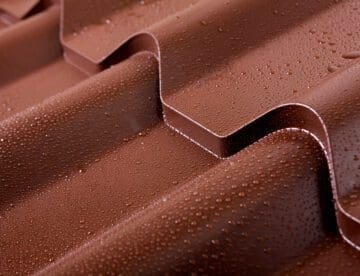Investing in energy-efficient roofing materials is one of the best ways to save money. Roofing materials that reflect the sun’s rays reduce heat transfer to your home. This lets you reduce annual air conditioning costs and energy bills in Florida’s hot and humid climate.
However, not only can certain roofing materials increase your roof’s energy efficiency, but they help reduce your utility bills. In addition, cool roofing has several financial and environmental benefits. For example, they improve indoor air quality, reduce pollution, help extend the life of roofing materials, and reduce the urban heat island effect in cities.
In this article, we’ll discuss how choosing the right energy-efficient roofing materials can save money and make your home more environmentally friendly.
Benefits of Energy-Efficient Roofing Materials
The primary benefit of energy-efficient roofing materials is to save money in energy costs. And the technology behind “cool roofs” is simple. Lighter roofs reflect the sun’s rays and heat better than dark roofs. Additionally, certain coatings and materials can increase heat reflectivity levels. The result? Less heat gets into your attic.
Here are three benefits of replacing your current roof with energy-efficient materials.
1. Save on Energy Bills
Cool roofs reduce the need to use your home’s HVAC system, thus reducing energy costs. A study at the University of Alabama found that “60 percent of heat transfer occurs through the roof, regardless of the weather.” By increasing roof insulation and installing a light-colored roof with reflective roofing materials, it is possible to reduce energy consumption significantly.
Some estimates put the savings at a 23 to 30 percent reduction in annual cooling bills.
2. Environmentally Friendly
Installing energy-efficient roofing benefits the environment. Because you use less energy, there is less demand on power stations, resulting in less pollution and greenhouse gas emissions. For example, the surface temperature of traditional roofs in Florida can reach 150°F on a hot, sunny afternoon. However, a reflective roof could reduce the roof temperature by 50 degrees.
Another environmental benefit of an energy-efficient roof is air quality. Preventing roofs from absorbing heat can help mitigate issues with urban heat islands.
What does this mean for residents of Florida? A study in Fort Lauderdale found that Florida’s hot seasons are up to three weeks longer than in the middle of the last century. And there is sometimes a 14°F difference in temperature between urban centers and the edge of urban areas. Therefore, a lighter-colored roof could help mitigate the problems of urban heat islands.
3. Extend the life span of your roof
A cost-saving benefit of energy-efficient roofing materials is that your roof lasts longer. In addition, the lighter roof color on “cool roofs” prevent harmful UV rays from affecting the roofing materials. And with Tampa Bay getting 246 days of sunshine annually, a cool roof can make your roof more durable.
All these benefits make investing in an energy-efficient roof a great way to save money while also helping the environment.
Types of Energy-Efficient Roofing Materials
Energy-efficient roofing materials come in various options, each with its benefits. The three principal types of energy-efficient roofs are cool roofs, green roofs, and solar roofs.
Green Roofs
Green roofs are roofs that are partially or completely covered with vegetation. These roofs help keep your home cool in the summer and warmer in the winter, saving on energy costs. Additionally, green roofs reduce rainwater runoff and can filter pollutants from the air. They also provide a natural habitat for birds, butterflies, and other wildlife.
Cool Roofs
Cool roofs have a special coating or material designed to reflect solar heat and reduce the heat your home absorbs. Metal roofing is the best material for a cool roof because metal reflects well and lasts longer in warmer climates.
Cool roof coatings are a white or gray reflective material to prevent the transfer of heat to your attic. Additionally, they last longer than traditional roofs as they are less susceptible to wear and tear due to extreme temperature changes.
Solar Roofs
Solar roofs have two benefits. First, they have panels that convert sunlight into free energy. Additionally, the reflective coating keeps your roof cooler, preventing your home from heating up in the summer. Therefore you save in two ways — free solar energy and lower cooling costs.
Factors to Consider When Choosing Energy-Efficient Roofing Materials
Choosing energy-efficient roofing materials is an important decision for any homeowner looking to save money on their energy bills. When making this choice, there are several factors you should consider.
First, consider the climate. Central Florida gets nearly 250 days of sunshine every year. Reports indicate that cool roofs save the most energy in hot, sunny climates, like the Southern United States.
Second, the cost is crucial when deciding on replacing a traditional roof with a cool or green roof. For example, metal roofs are more durable in Florida’s climate and require little maintenance throughout their lifespan. However, they can be more expensive with higher upfront costs than light-colored asphalt shingles or tiles.
Lastly, it would be best to consider your roof’s shape and slope. The choice of roofing material can be limited depending on whether you have a flat roof or a steep slope.
Cost Savings with Energy-Efficient Roofing Materials
It’s no secret that energy-efficient roofing materials can be a great way to save money. Not only are these materials more efficient at keeping your home cool in the summer and warm in the winter, but they also typically last longer than traditional roofing materials.
How much could installing a cool roof save you in Florida? A study by the University of Florida found that energy use in homes during summer was reduced by 19 percent. In addition, the EPA reports that households could save $0.50 per square foot annually in hot, sunny climates.
Additionally, many energy-efficient roofing materials come with tax incentives or other financial benefits from local utility companies.
Therefore, it pays to contact a local roofing contractor to find out about the best energy-efficient roofing options in the Tampa Bay area.
With these cost savings in mind, it’s easy to see why investing in energy-efficient roofing is a smart decision for any homeowner looking to save money on their energy bills.
Maintenance and Longevity of Energy-Efficient Roofing Materials
Maintaining and extending the longevity of energy-efficient roofing materials maximize your cost savings potential. In addition, cool roofs, green roofs, and solar roofs protect roofing materials from damaging UV rays, moisture, and other environmental factors.
Here are some helpful tips on ensuring your cool, energy-efficient roof lasts for decades:
- Get a qualified, professional roofing contractor to install the energy-efficient roof.
- Keep gutters clean and keep trees away from the roof.
- Carry out a roof inspection annually to check for potential storm damage caused by extreme weather events.
Conclusion
Energy-efficient roofing materials are an excellent way to enjoy massive energy savings and save money on electricity bills. Cool roofing products reduce the energy required to keep your home at a comfortable temperature. Also, they can last longer than traditional roofing options. Therefore, an energy-efficient roof is a great long-term investment.
So if you’re looking to make your home more environmentally friendly and wallet-friendly, installing an energy-efficient roof is worth considering.




